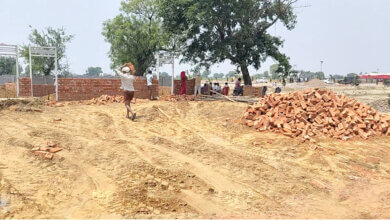

Ayodhya, the birthplace of Lord Rama, is one of India’s most celebrated spiritual destinations. Steeped in mythology, devotion, and historical significance, this ancient city attracts millions of pilgrims every year. While the Ram Mandir stands as its crowning glory, Ayodhya’s spiritual landscape is vast, encompassing hidden temples, sacred ghats, and mystical legends. Among these, Hanuman Gadi Ayodhya holds a special place as a fortress of divine protection and devotion.
For devotees unable to visit in person, online puja service offer a way to connect with Ayodhya’s sacred energy, allowing remote participation in rituals and receiving blessings from afar.
This guide explores the must-visit places around Ayodhya, their significance, and how you can experience their spiritual power, whether in person or through digital devotion.
1. Hanuman Gadi – The Divine Fortress of Lord Hanuman
Why Visit Hanuman Gadi Ayodhya?
Built on a hilltop in the heart of Ayodhya, Hanuman Gadi is one of the most prominent temples dedicated to Lord Hanuman. The temple’s unique structure, resembling a fortress, symbolizes strength and protection. According to legend, Hanuman resided here to guard Ayodhya in Lord Rama’s absence.
Architecture & Spiritual Significance
- The temple is accessed by climbing 76 steps, representing the 76 incarnations of Lord Hanuman.
- The inner sanctum houses a powerful idol of Hanuman in a childlike form (Bal Hanuman), believed to fulfill sincere prayers.
- Devotees offer sindoor (vermilion) and besan ke laddoo, Hanuman’s favorite offerings, seeking his blessings for courage and success.
Best Time to Visit
- Morning & Evening Aarti: The temple comes alive with rhythmic chants and devotional hymns.
- Tuesdays & Saturdays: Special days dedicated to Hanuman, attracting large crowds.
For Remote Devotees
Can’t visit in person? Platforms like Utsav app offer online puja service where priests perform rituals on your behalf and send prasad to your home.
Visit Utsavapp for booking personalized online puja service and receive live puja status and video via whatsapp and authentic puja prasad at home within 7 working days.
2. Ram Ki Paidi – The Sacred Ghats of Sarayu River
The Spiritual Importance of Ram Ki Paidi
A series of 84 ghats along the Sarayu River, Ram Ki Paidi is where devotees perform holy dips, believing it washes away sins and purifies the soul. The river itself is considered sacred, mentioned in ancient scriptures as a divine waterbody.
Key Highlights
- Evening Ganga Aarti: A breathtaking spectacle with lamps floating on the river, accompanied by Vedic chants.
- Makara Sankranti & Solar Eclipses: Thousands gather for special rituals during these auspicious times.
Nearby Attractions
- Guptar Ghat: Where Lord Rama is believed to have taken Jal Samadhi (water immersion).
- Raj Ghat: A serene spot for meditation and reflection.
3. Kanak Bhawan – The Golden Palace of Sita
The Legend Behind Kanak Bhawan
This exquisite temple is said to have been gifted to Sita by Queen Kaikeyi after her marriage to Lord Rama. The sanctum houses gold-plated idols of Rama and Sita, adorned with intricate jewelry.
Why It’s a Must-Visit
- Unique Architecture: The temple’s vibrant paintings and carvings depict scenes from the Ramayana.
- Divine Love Symbolism: Couples visit to seek blessings for a harmonious marriage.
Best Time for Darshan
Early morning or late evening for a peaceful experience.
4. Treta Ke Thakur – The Ancient Yajna Site
Historical & Mythological Significance
This temple marks the spot where Lord Rama performed the Ashwamedha Yajna after returning from exile. The idols here are believed to be Swayambhu (self-manifested) and date back to the Treta Yuga.
What Makes It Special?
- The black sandstone idols of Rama, Sita, Lakshman, and Hanuman have a powerful aura.
- A sacred well inside the temple is said to have healing properties.
Rituals to Observe
- Lighting a diya (lamp) for prosperity.
- Offering tulsi leaves to the deities.
5. Nageshwarnath Temple – A Legacy of Lord Shiva
The Story of Its Origin
Built by Kush, Lord Rama’s son, this temple is dedicated to Lord Shiva. Legend says Kush retrieved a lost armlet here, leading to the temple’s construction.
Why Visit?
- One of the few Shiva temples in Ayodhya, making it unique.
- Maha Shivaratri celebrations are grand, with night-long prayers.
6. Sita Ki Rasoi – The Divine Kitchen
A Glimpse into Sita’s Household
This symbolic kitchen represents the place where Goddess Sita cooked meals during her time in Ayodhya.
What to See Here
- Utensils and artifacts believed to be from the Ramayana era.
- Devotees offer rice and sweets as a mark of devotion.
7. Gulab Bari – The Rose Garden of Nawabs
A Blend of Spirituality & History
While not a temple, this Mughal-era garden houses the tomb of Nawab Shuja-ud-Daula and offers a peaceful retreat.
Why Include It in Your Itinerary?
- Beautiful rose gardens and fountains.
- A refreshing break from temple visits.
How to Experience Ayodhya’s Blessings Remotely?
For those unable to travel, online puja service provide a way to:
✔ Book live-streamed artis at Hanuman Gadi Ayodhya or Ram Mandir.
✔ Arrange personalized rituals with Vedic priests.
✔ Receive blessed prasad at home.
Platforms like Utsav App facilitate these services, ensuring you stay connected to Ayodhya’s divine energy.
Final Thoughts
Ayodhya is not just about the Ram Mandir, it’s a spiritual universe where every corner tells a story of devotion. From the protective aura of Hanuman Garhi Ayodhya to the tranquil Sarayu ghats, each site offers unique blessings.
Whether you visit in person or through online puja service, Ayodhya’s sacred vibrations can transform your spiritual journey.
Plan your pilgrimage or book a virtual puja today to invite Ayodhya’s divine grace into your life.




